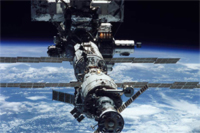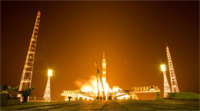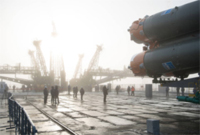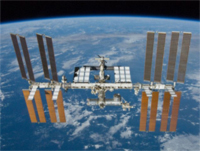International Space Station
What is Space Station?
The International Space Station is a large spacecraft. It orbits around Earth. It is a home where astronauts live. The space station is also a science lab. Many countries worked together to build it. They also work together to use it. The space station is made of many pieces. The pieces were put together in space by astronauts. The space station’s orbit is approximately 250 miles above Earth. NASA uses the station to learn about living and working in space. These lessons will help NASA explore space. The International Space Station is a unique place – a convergence of science, technology and human innovation that demonstrates new technologies and makes research breakthroughs not possible on Earth. It is a microgravity laboratory in which an international crew of six people live and work while traveling at a speed of five miles per second, orbiting Earth every 90 minutes. The space station has been continuously occupied since November 2000. In that time, 222 people from 18 countries have visited. Crew members spend about 35 hours each week conducting research in many disciplines to advance scientific knowledge in Earth, space, physical, and biological sciences for the benefit of people living on our home planet.




How Old and Big is the Space Station?
The first piece of the International Space Station was launched in 1998. A Russian rocket launched that piece. After that, more pieces were added. Two years later, the station was ready for people. The first crew arrived on November 2, 2000. People have lived on the space station ever since. Over time more pieces have been added. NASA and its partners around the world finished the space station in 2011. The space station is as big inside as a house with five bedrooms. It has two bathrooms, a gymnasium and a big bay window. Six people are able to live there. It weighs almost a million pounds. It is big enough to cover a football field including the end zones. It has science labs from the United States, Russia, Japan and Europe.
What are the parts of Space Station?
The space station has many parts. The parts are called modules. The first modules had parts needed to make the space station work. Astronauts also lived in those modules. Modules called “nodes” connect parts of the station to each other. Labs on the space station let astronauts do research.
On the sides of the space station are solar arrays. These arrays collect energy from the sun. They turn sunlight into electricity. Robot arms are attached outside. The robot arms helped to build the space station. They also can move astronauts around outside and control science experiments. Airlocks on the space station are like doors. Astronauts use them to go outside on spacewalks. Docking ports are like doors, too. The ports allow visiting spacecraft to connect to the space station. New crews and visitors enter the station through the docking ports. Astronauts fly to the space station on the Russian Soyuz. The crew members use the ports to move supplies onto the station.
Why is the Space Station important?
The space station is a home in orbit. People have lived in space every day since the year 2000. The space station’s labs are where crew members do research. This research could not be done on Earth. Scientists study what happens to people when they live in space. NASA has learned how to keep a spacecraft working for a long time. These lessons will be important in the future. NASA has a plan to send humans deeper into space than ever before. The space station is one of the first steps. NASA will use lessons from the space station to get astronauts ready for the journey ahead.
15 ways the International Space Station is benefiting the Earth
Here are 15 ways the space station is benefiting life on Earth:
- Commercializing low-Earth orbit.
- Supporting water purification efforts worldwide.
- Growing high-quality protein crystals.
- Bringing space station ultrasound to the ends of the Earth.
- Improving eye surgery with space hardware.
- Making inoperable tumors operable with a robotic arm.
- Preventing bone loss through diet and exercise.
- Understanding the mechanisms of osteoporosis.
- Developing improved vaccines.
- Providing students opportunities to conduct their own science in space
- Breast cancer detection and treatment technology.
- Monitoring water quality from space.
- Monitoring natural disasters from space.
- Describing the behavior of fluids to improve medical devices.
- Improving indoor air quality.
International Space Station Facts
Some of the facts about Iss
- An international crew of six people live and work while traveling at a speed of five miles per second, orbiting Earth about every 90 minutes.
- In 24 hours, the space station makes 16 orbits of Earth, traveling through 16 sunrises and sunsets.
- Peggy Whitson set the record for spending the most total time living and working in space at 665 days on Sept. 2, 2017.
- The acre of solar panels that power the station means sometimes you can look up in the sky at dawn or dusk and see the spaceship flying over your home, even if you live in a big city.
- The living and working space in the station is larger than a six-bedroom house (and has six sleeping quarters, two bathrooms, a gym, and a 360-degree view bay window).
- The large modules and other pieces of the station were delivered on 42 assembly flights, 37 on the U.S. space shuttles and five on Russian Proton/Soyuz rockets.
- The space station is 357 feet end-to-end, one yard shy of the full length of an American football field including the end zones.
- A spacecraft can arrive at the space station as soon as six hours after launching from Earth.
- Four different cargo spacecraft deliver science, cargo and supplies: Orbital ATK’s Cygnus, SpaceX’s Dragon, JAXA’s HTV, and the Russian Progress.
- The space station has an internal pressurized volume equal that of a Boeing 747.
- More than 50 computers control the systems on the space station.
- More than 3 million lines of software code on the ground support more than 1.5 million lines of flight software code.
Solar System | Mercury | Venus Moons | Earth | Mars Moons | Jupiter Moons | Saturn Moons | Uranus Moons | Neptune Moons | International Space System | ISS Research | Moons of the planet | Magnetosphere | Regions Of Comets | Space Station Glossary | Space Station Abbreviation | Space Station Sitemap | Asteriods | Contact Us